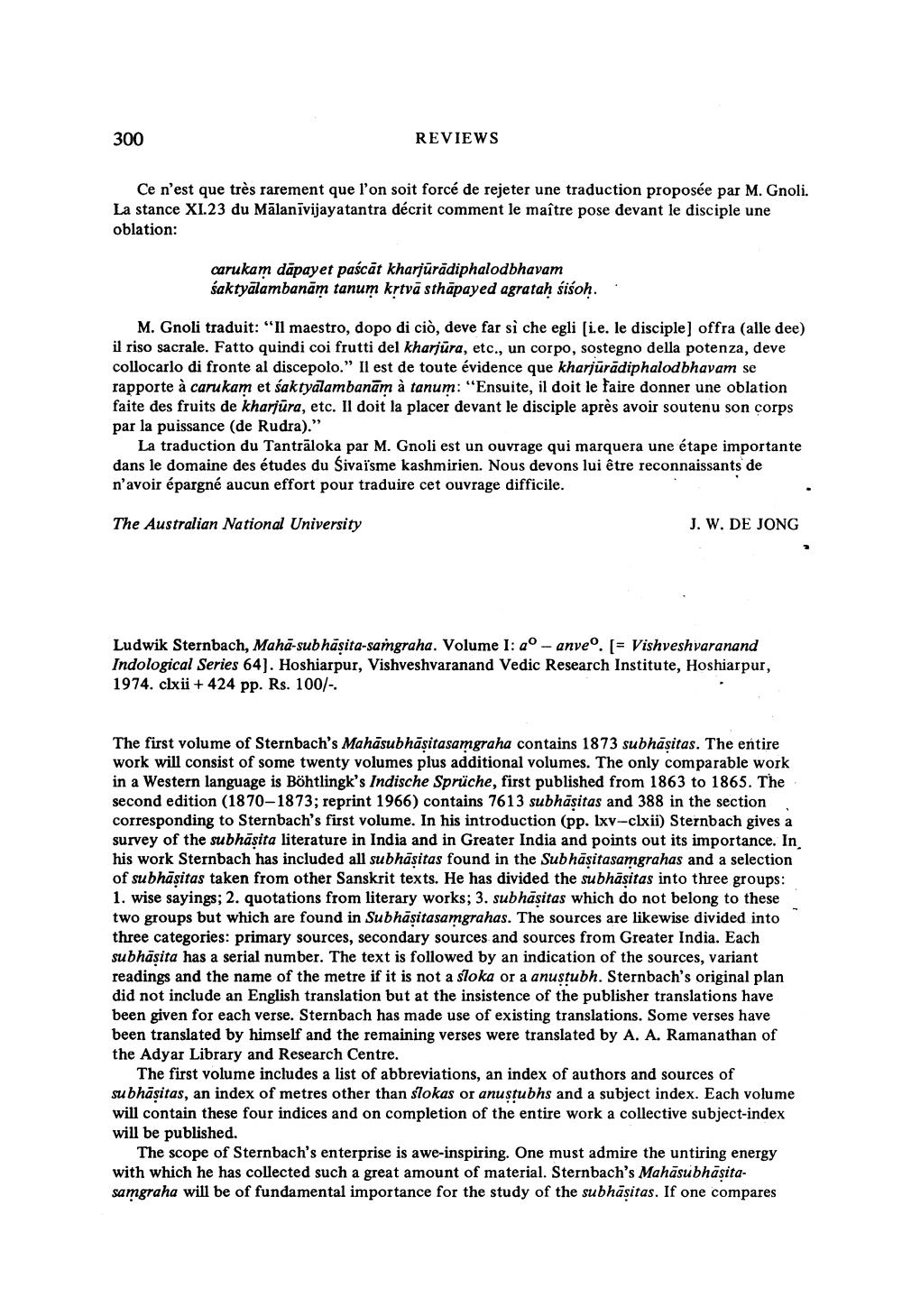Book Title: Reviews Of Different Books Author(s): J W De Jong Publisher: J W De Jong View full book textPage 4
________________ 300 REVIEWS Ce n'est que très rarement que l'on soit forcé de rejeter une traduction proposée par M. Gnoli. La stance XI.23 du Mālanīvijayatantra décrit comment le maître pose devant le disciple une oblation: carukam dāpayet paścāt kharjūrādiphalodbhavam śaktyālambanām tanum krtvā sthāpayed agrataḥ śiśoh.. M. Gnoli traduit: "Il maestro, dopo di ciò, deve far sì che egli (i.e. le disciple] offra (alle dee) il riso sacrale. Fatto quindi coi frutti del kharjūra, etc., un corpo, sostegno della potenza, deve collocarlo di fronte al discepoto." Il est de toute évidence que kharjūrādiphalodbhavam se rapporte à carukam et saktyalambanām à tanum: "Ensuite, il doit le faire donner une oblation faite des fruits de kharjūra, etc. Il doit la placer devant le disciple après avoir soutenu son corps par la puissance (de Rudra)." La traduction du Tantrāloka par M. Gnoli est un ouvrage qui marquera une étape importante dans le domaine des études du Sivaïsme kashmirien. Nous devons lui être reconnaissants de n'avoir épargné aucun effort pour traduire cet ouvrage difficile. The Australian National University J. W. DE JONG Ludwik Sternbach, Mahā-subhasita-sangraha. Volume I: ao-anve. [= Vishveshvaranand Indological Series 64). Hoshiarpur, Vishveshvaranand Vedic Research Institute, Hoshiarpur, 1974. clxii + 424 pp. Rs. 100/-. The first volume of Sternbach's Mahāsubhāṣitasamgraha contains 1873 subhāṣitas. The entire work will consist of some twenty volumes plus additional volumes. The only comparable work in a Western language is Böhtlingk's Indische Sprüche, first published from 1863 to 1865. The second edition (1870-1873; reprint 1966) contains 7613 subhasitas and 388 in the section , corresponding to Sternbach's first volume. In his introduction (pp. lxv-clxii) Sternbach gives a survey of the subhasita literature in India and in Greater India and points out its importance. In his work Sternbach has included all subhasitas found in the Subhasitasamgrahas and a selection of subhāsitas taken from other Sanskrit texts. He has divided the subhasitas into three groups: 1. wise sayings; 2. quotations from literary works; 3. subhāsitas which do not belong to these two groups but which are found in Subhasitasamgrahas. The sources are likewise divided into three categories: primary sources, secondary sources and sources from Greater India. Each subhasita has a serial number. The text is followed by an indication of the sources, variant readings and the name of the metre if it is not a sloka or a anustubh. Sternbach's original plan did not include an English translation but at the insistence of the publisher translations have been given for each verse. Sternbach has made use of existing translations. Some verses have been translated by himself and the remaining verses were translated by A. A. Ramanathan of the Adyar Library and Research Centre. The first volume includes a list of abbreviations, an index of authors and sources of subhāsitas, an index of metres other than slokas or anustubhs and a subject index. Each volume will contain these four indices and on completion of the entire work a collective subject-index will be published. The scope of Sternbach's enterprise is awe-inspiring. One must admire the untiring energy with which he has collected such a great amount of material. Sternbach's Mahāsubhasitasamgraha will be of fundamental importance for the study of the subhāsitas. If one comparesPage Navigation
1 2 3 4 5 6 7 8 9 10 11 12 13 14 15 16 17 18 19 20 21 22 23 24 25 26 27 28 29 30 31 32
